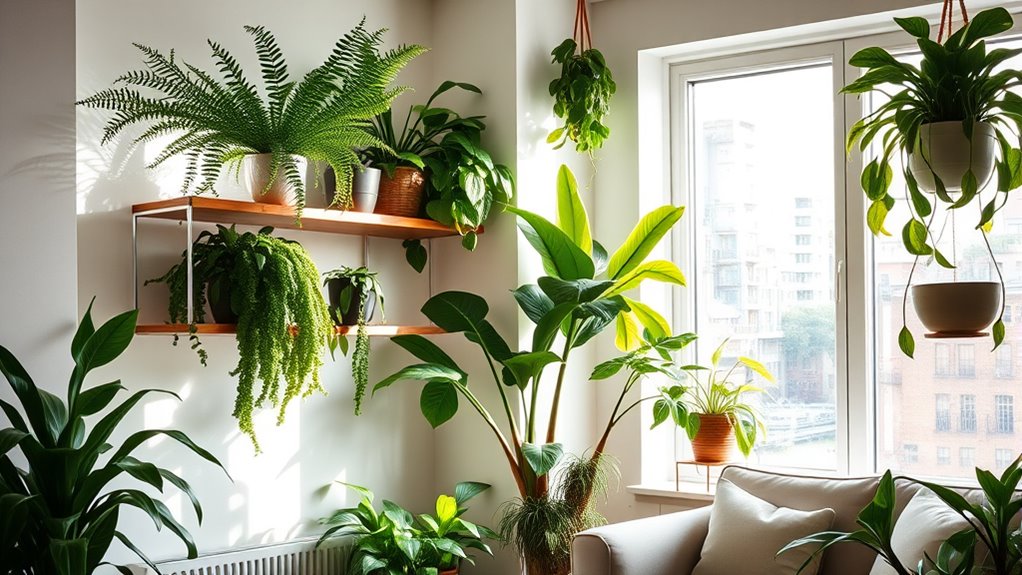To purify your apartment’s air through urban farming, choose plants like snake plants, pothos, and peace lilies. These plants absorb airborne toxins such as formaldehyde and benzene while releasing oxygen, creating healthier indoor environments. Growing herbs and vegetables also reduces reliance on store-bought produce and lowers your carbon footprint. Incorporating these plants not only improves air quality but also supports sustainable living—keep exploring to discover more ways to boost your space’s freshness naturally.
Key Takeaways
- Indoor plants like snake plants, pothos, and peace lilies effectively absorb airborne toxins, improving apartment air quality.
- Urban farming in small spaces promotes sustainable practices and reduces reliance on store-bought air-purifying products.
- Growing houseplants indoors helps filter pollutants such as formaldehyde, benzene, and trichloroethylene from the air.
- Incorporating greenery into apartments creates healthier environments and supports eco-friendly urban living.
- Urban farming encourages mindful cultivation of herbs and plants that naturally purify indoor air.

Have you ever wondered how cities are turning concrete jungles into green havens? The answer lies in urban farming, a movement that transforms small spaces into lush, productive environments. But beyond growing your own food, urban farming also plays a crucial role in improving indoor air quality. As cities become more crowded and pollution levels rise, the air inside your apartment can trap toxins and allergens, making it harder to breathe and stay healthy. Integrating plants into your living space isn’t just about aesthetics; it’s a practical way to purify the air you breathe daily. Certain houseplants, like snake plants, pothos, and peace lilies, are known for their ability to filter out harmful substances such as formaldehyde, benzene, and trichloroethylene. These plants absorb airborne toxins through their leaves and roots, releasing fresh oxygen and improving overall indoor air quality. By cultivating a variety of these plants, you create a mini ecosystem that combats pollution and enhances your well-being.
Urban farming also aligns with the principles of sustainable agriculture, which emphasizes eco-friendly practices that conserve resources and promote biodiversity. When you grow your own herbs, vegetables, or even small fruit trees indoors or on balconies, you reduce reliance on store-bought produce that often involves extensive transportation and packaging, both of which contribute to environmental degradation. Growing food locally means fewer carbon emissions and less waste, making your apartment a tiny hub of sustainable agriculture. Plus, tending to your plants encourages mindful consumption and a deeper connection to your environment. You learn about soil health, water conservation, and organic practices that minimize chemical use, supporting a healthier planet. This approach not only benefits the environment but also ensures that what you consume is fresh, free of pesticides, and packed with nutrients. Additionally, understanding the nutritional value of juices can motivate you to incorporate fresh, homegrown produce into your diet for maximum health benefits.
Incorporating plants into your apartment isn’t just about decoration; it’s a strategic move toward healthier living and environmental stewardship. As you care for your indoor garden, you actively participate in reducing your carbon footprint and improving your immediate environment. Whether you’re growing herbs for your meals or placing air-purifying plants around your living space, each effort contributes to cleaner air and a more sustainable lifestyle. Urban farming isn’t just a trend; it’s a practical solution to urban challenges, allowing you to enjoy fresher air, better health, and a greener home. When you embrace this lifestyle, you’re not only transforming your apartment but also supporting the broader movement toward sustainable urban living.
Frequently Asked Questions
Which Plants Are Safest for Homes With Pets?
When choosing pet safe plants, you avoid toxic plant avoidance to keep your pets healthy. You should look for pet safe plants like spider plants, Boston ferns, and areca palms, which are non-toxic to cats and dogs. Always research specific plants before bringing them home. By selecting pet safe plants, you create a safe environment, ensuring your pets enjoy your apartment without risk of poisoning or health issues.
How Often Should Indoor Plants Be Watered for Optimal Air Purification?
They say “a little water goes a long way,” and that’s true for indoor plants. To keep your plants healthy and maximize air purification, follow a consistent watering schedule—usually once a week, but adjust for each plant’s needs. Overwatering can harm plant health and reduce their ability to clean the air, so check soil moisture regularly. Proper care makes certain your indoor jungle thrives and purifies your space effectively.
Do Air-Purifying Plants Require Special Soil or Fertilizers?
You might wonder if air-purifying plants need special soil or fertilizers. Generally, they thrive in well-draining soil with basic nutrients, so you don’t need elaborate soil requirements. Most only need occasional fertilizers, like a balanced liquid fertilizer every month or two, to stay healthy. Focus on proper watering and light, and your plants will naturally purify the air without needing complex soil or frequent fertilization.
Can Urban Farming Reduce Indoor Allergies Effectively?
Urban farming can effectively reduce indoor allergies by decreasing airborne allergen levels and improving air quality. As you grow plants, they help filter out pollutants and trap airborne allergens, aiding in airborne allergen reduction. Additionally, choosing low-pollen plants helps with plant pollen control, minimizing allergy triggers. Regular watering and maintenance guarantee these plants thrive, creating a healthier indoor environment where allergy symptoms are less severe.
What Are the Best Light Conditions for Maintaining Healthy Indoor Plants?
To keep your indoor plants healthy, you need the right light conditions. Most plants thrive in natural light, so place them near windows that get plenty of sunlight. If natural light is limited, supplement with artificial lighting like LED grow lights to mimic sunlight. Make sure you adjust the light duration and intensity based on your plants’ needs, helping them grow strong and purify your space effectively.
Conclusion
By starting your own urban farm, you’ll transform your apartment into a lush, oxygen-rich paradise so vibrant, it’ll feel like breathing in the very essence of nature itself. Imagine fresh air flowing endlessly, enveloping you in a never-ending breeze of energy and serenity. With every plant you nurture, you’re not just cleaning your space—you’re creating a miniature jungle that could rival the Amazon in purity. Get growing, and breathe in the extraordinary!











